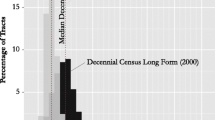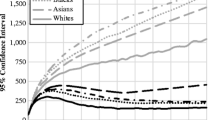Abstract
The American Community Survey (ACS) is a Census Bureau product designed to provide accurate and timely demographic and economic indicators on an annual basis for both large and small geographic areas within the United States. Operational plans for Census 2010 call for ACS to replace the decennial census long form (Census LF), pending the results of evaluation studies. This plan represents a major change in that variables that traditionally have been collected on a “snapshot” basis once every 10 years would be collected on a “rolling” annual basis. Using a loss function analysis and other tools, this paper reports preliminary findings from a comparison of ACS and Census 2000 results in Multnomah County, Oregon, one of five national “local expert” test sites set up to compare ACS data collected at the time of Census 2000. The preliminary findings suggest that there are notable differences between some of the corresponding variables found in the ACS and Census LF that require more detailed examination. For example, the loss function analysis reveals notable differences for race and disability variables. In other comparisons of corresponding variables between ACS and Census 2000, differences are found within each of the four major areas of interest: (1) demographic characteristics, (2) social characteristics, (3) economic characteristics, and (4) housing characteristics, with housing characteristics showing the least similarity overall. These results also suggest that more detailed examinations are needed to understand differences between corresponding variables collected by ACS and the Census LF.
Similar content being viewed by others
Explore related subjects
Discover the latest articles and news from researchers in related subjects, suggested using machine learning.References
Ayre, A. (2003). Why does Oregon have a high unemployment rate? Oregon Labor Market Information System. Salem OR: Oregon Employment Department.
Bryan, T. (2000). U.S. Census Bureau Population estimates and evaluation with loss functions. Statistics in Transition, 4, 537–549.
Edmonston, B., & Lee, S. (2001). American Community Survey case study project: Portland, Oregon. Use of the American Community Survey for educational planning in Portland public schools. Portland OR: Population Research Center, Portland State University.
Hodges, K. (1996). The state of the Census: Census 2000 status report. New Orleans LA: Paper presented at the Claritas Decision-Making Conference.
Hough, G., & Swanson, D. (1998). Towards an assessment of continuous measurement: A comparison of returns with 1990 census returns for the Portland test site. Journal of Economic and Social Measurement, 24, 295–308.
Kirk, R. (1968). Experimental design: Procedures for the behavioral sciences. Belmont CA: Brooks.
Love, S., Dalzell, D., & Alexander, C. (1995). Constructing a major survey: Operational plans and issues for continuous measurement. Paper presented at the annual meeting of the American Statistical Association.
McLaughlin, D. K., Melz, H. M., Lichter, D. T., & Gardner, E. L. (2001). The quality of rural population estimates from the American Community Survey. Journal of Economic and Social Measurement, 26, 193–230.
National Academy of Sciences (1980). Estimating population and income of small areas. Washington DC: National Academy Press.
National Research Council (1995). Modernizing the U.S. Census. Washington DC: National Academy Press.
Perenger, T. (1998). What is wrong with Bonferroni adjustments? British Medical Journal, 136, 1236–1238.
Robinson, J. G., Ahmed, B., Das Gupta, P., & Woodrow, K. A. (1991). Estimating coverage of the 1990 United States Census: Demographic analysis. Paper presented at the annual meeting of the American Statistical Association.
Salvo, J., & Lobo, A. P. (1997). The American Community Survey: Non-response follow-up in the Rockland County test-site. Paper presented at the annual meeting of the American Statistical Association.
Smith, A. S. (1998). The American Community Survey and intercensal population estimates: Where are the crossroads? Population Division Technical Working Paper No. 31. U.S. Census Bureau.
Swanson, D., Tayman, J., & Barr, C. (2000). A note on the measurement of accuracy for subnational demographic estimates. Demography, 37(2), 193–201.
Taeuber, C., Lane, J., & Stevens, D. (2000). Meeting state and community needs for social, economic, and housing information: The why, what, and how of converting program records and summarized survey data to state and community information systems. Paper presented at the conference, “Developing Public Policy Applications with Summarized Survey Data and Community Administrative Records,” June 6–7, 2000.
U.S. Census Bureau. (2001a). Meeting 21st Century demographic data needs—Implementing the American Community Survey: July 2001. Report 1: Demonstrating Operational Feasibility. Washington DC: U.S. Census Bureau.
U.S. Census Bureau. (2001b). The American Community Survey, updated information for America’s communities, November 2001 (ACS/01-BLKT). Washington DC: U.S. Census Bureau.
U.S. Census Bureau (2003). American Community Survey Operations Plan. Release 1: March 2003.
U.S. Census Bureau (2004). About the American Community Survey. Available at: http://www.census.gov/CMS/www/acs.htm [January, 2004].
VanderVliet, A. (2002). Portland metro labor trends, February 2002. Salem OR: Oregon Employment Department.
Author information
Authors and Affiliations
Corresponding author
Rights and permissions
About this article
Cite this article
Hough, G.C., Swanson, D.A. An evaluation of the American Community Survey: results from the Oregon test site. Popul Res Policy Rev 25, 257–273 (2006). https://doi.org/10.1007/s11113-006-0007-1
Published:
Issue Date:
DOI: https://doi.org/10.1007/s11113-006-0007-1


